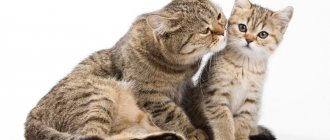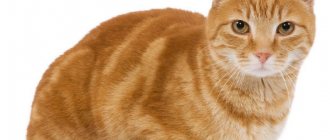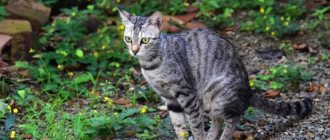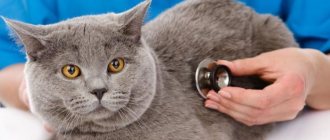General information about the constitution of the Scottish kitten
Breeders of Scottish and British kittens often like to monitor the process of their pet's weight gain. They carefully monitor how the Scottish kitten grows and changes in weight during the first year of life. This is important for the breed quality of the animal and subsequently determines its status.
How much does a Scottish cat weigh? The Scots are not particularly large in size; they are somewhat more graceful than their British “relatives”. Regardless of whether your breed is lop-eared or straight-eared, the weight standards for both breeds are the same.
The Scottish cat is a harmoniously built breed. Representatives of this breed are quite stocky and muscular, with a medium length and body weight. An adult Scotsman usually weighs between 5 and 7 kg. Weight also depends on gender. There are cases when representatives of this breed gain significantly more than the norm. Therefore, it is quite difficult to answer the question of how much a Scots cat should weigh.
© shutterstock
Character and behavior
Looking at the imposing and massive Scottish Straights, you might think that they are lazy and do not see beyond their food bowl. Not at all! Of course, among cats of this breed (as well as among individuals of other breeds) there are many phlegmatic animals, but not all have such a specific character. Scottish Straights are reasonable and careful, they look closely and think for a long time before taking on any business, but this does not mean at all that they are stupid or slow.
Scottish Straights can run as fast as their feline counterparts and love new toys and running around. They just need a little more rest and quiet. They are not hermits or beeches: Scottish Straights love to be the center of attention, but they also easily tolerate loneliness.
The peak of playfulness occurs in the first couple of years of their life; for the rest of the years, cats prefer a leisurely existence in comfort and coziness, next to their favorite representatives of the human race.
They are careful, restrained in expressing feelings, but affectionate and very patient. These are the same cats that you can have in a family with small children. Scottish will never allow himself to scratch a child or scare him with a loud hiss. If the cat is “pushed”, he will silently run away and hide, but will not take revenge. They are not vindictive or vindictive, and do not suffer from mood swings, but they can be very persistent and even obsessive. If they really want something, they will follow you on your heels and scream until victory.
Name the cat who always wanted to live together
BasilioLeopold
They respond well to learning basic skills - going to their litter box (How to train a kitten to use the litter box?), eating at certain hours, not stealing from the table - but training is not for them. They get along well with other cats and even dogs, but they do not like small animals.
A change of environment is difficult for them, as is moving. They are afraid of heights, loud sounds and do not like water.
Weight of newborn kittens
The weight of the cub is directly related to the total size of the litter. Accordingly, if there are only three kittens in a litter, then their weight will be significantly higher than in a litter of six kittens.
When born, Scottish kittens weigh from 60 to 140 grams. Where 60 is considered the minimum normal limit.
Again, it is worth looking at the number of kittens. In addition, the course of a cat’s pregnancy also plays a big role. If the cat rested well, slept well, ate properly and healthy, then the kittens will be born well-fed and healthy.
How much does a newborn kitten weigh?
At birth, not only the norms for a single kitten are important, but also the total number of kittens when there is more than one. If, for example, 5 kittens were born, then the weight of each will be significantly less than if only 3 were born. The cat’s womb, in which they were formed before birth, is limited throughout life. There is nowhere to find free space - there is a limit for each adult female. Nature came up with a way out of the situation by reducing the mass of each of the cubs born by a given individual.
Subsequently, the weight of each kitten will approach the age norm for the first year of life, but it is worth providing all kittens with additional complementary foods when the mother cat produces little milk. The typical weight of Scottish kittens at birth is 60-140 g . If the cat is provided with an adequate diet, rest and walks, then the kittens will not be critically underweight.
Rate of weight gain during the first days of life
During the first two weeks of life, a Scottish kitten gains weight quite quickly. He gains approximately 10-20g daily.
During this important period, you should especially monitor your cat's nutrition. It must be complete and sufficient. Even if your cat overeats, you should not limit it. At the end of feeding, the cat’s weight will stabilize on its own.
Based on the above data, it should be concluded that the weight of the cubs grows by 100-200 grams per week. By two weeks of age, kittens can reach a weight of 140-400 grams. This gap is related to the number of litters and the sex of the kitten. Cats are naturally lighter than cats.
By the third week of life, the babies are already a little stronger and they can add complementary foods to the main diet (mother's milk). Complementary feeding should consist of high-quality products; you cannot skimp on this, because development in the very first days and weeks of life is the key to health in the future.
© shutterstock
Three months
From now until six months, kittens are supposed to gain 100 grams per day. It is at this time that kittens, especially those separated from their mother, should be fed high-quality food. In addition, they need all kinds of vitamins.
It is from this age that veterinarians recommend that owners definitely decide what exactly they will feed their furry pets. You need to choose between good cat food and food made from natural products, which will have to be prepared specifically for the four-legged cat.
It is not recommended to combine both options in your diet. When the owner purchases high-quality food for the cat, the animal is already supplied with the necessary amount of important proteins, fats, minerals and vitamins, so if you supplement the pet with some products, it is possible to overload the useful components.
And, in addition, this can lead to excess weight gain.
Kitten weight up to six months
By the first month, the cubs gain from 250 to 750 grams. Naturally, the weight gain criteria are an individual factor, and we indicate everything “averaged.”
The second month of life brings with it from 200g to 1kg of weight. And by the third month, the rate of weight gain decreases slightly. The older a Scot gets, the less he gains.
It is also necessary to take into account the genetics of the parents, because to a large extent it determines how large the offspring will be.
From the fourth month, the kitten is a teenager, and weight growth up to six months ranges from 500g to 2kg.
How to weigh
Determining the weight of a kitten at first glance seems somewhat complicated. However, everything is quite simple.
Methods:
- The first method is the most common, weighing on an electronic kitchen scale. Such scales show the result quite accurately, making weighing kittens from 0 months old very easy and simple.
- The second method also has the right to life. Here it is suggested to use commercial hand scales with a hook. To measure mass this way, you will need a bag or some other container to place the cat in. The container is pre-weighed separately. This method of measurement is far from the most accurate.
- The third method is more likely for adult animals whose weight is from 1 kg. You need floor scales on which you weigh yourself and then weigh yourself with your pet. The difference between the first and second weighing will be equal to the weight of the cat.
- The surest, but not the most convenient way, is to weigh the kitten in a veterinary clinic on special scales.
Weight growth chart
For greater convenience, we suggest you use the table. The table will show the usual rate of weight gain for Scottish kittens from 0 to 12 months.
| Scottish kitten age | Weight for a cat, kg | Weight for a cat, kg |
| Newborn kitten | 0.06-0.14 | 0.07-0.14 |
| 1st week | 0.11-0.25 | 0.24-0.26 |
| 2nd week | 0.14-0.36 | 0.34-0.4 |
| 3rd week | 0.2-0.42 | 0.39-0.63 |
| 1 month | 0.24-0.6 | 0.54-0.74 |
| 2 months | 0.4-0.9 | 1.0-1.7 |
| 3 months | 1.0-1.5 | 1.5-2.5 |
| 4 months | 1.7-2.4 | 2.1-3.9 |
| 5 months | 2.2-2.9 | 2.6-4.3 |
| 6 months | 2.3-3.6 | 3.0-5.4 |
| 7 months | 2.4-3.9 | 3.3-5.6 |
| 8 months | 2.5-4.1 | 3.5-6.0 |
| 9 months | 2.5-4.3 | 3.8-6.4 |
| 10 months | 2.5-4.4 | 4.1-6.7 |
| 11 months | 2.5-4.5 | 4.3-6.8 |
| 12 months/1 year | 2.5-4.6 | 4.5-7.0 |
Recommendations for introducing complementary foods
For meat products, it is recommended to give preference to boiled or pre-frozen beef.
- Initially, you can put small pieces directly into the kitten’s mouth, and then gradually begin to accustom him to the plate. At 2.5 months, the pet should already be able to eat on its own.
- It is not recommended to give several different foods at once - this can lead to constipation. Also, if an animal develops an allergy, it will be difficult to determine what exactly. You can detect an allergic reaction by lifting the kitten's tail - there will be yellowish stains under it.
- The best source of calcium is cream with 10-15% fat content - it can be given 2 times a week in small portions from 4 weeks.
You should not feed your kitten canned food, purees, pasta or minced meat - these products have a negative effect on the digestive tract and can cause diarrhea.
At 1 year of age, you can stop monitoring your pet’s weight every month—after that, there won’t be much noticeable changes in your pet’s size or weight.
If the weight of a fold-eared cat is significantly lower than the specified minimum values, and tests do not reveal problems in the digestive tract, the doctor will help balance the diet and prescribe a vitamin complex.
If the Scottish Fold is visibly overweight, it is recommended to reduce the portions of the Scottish Fold's food and increase its physical activity - for this it is recommended to spend more time walking with the kitten. Obese pets increase the risk of diabetes mellitus and the development of problems in the cardiovascular system.
How to feed little Scots
As mentioned above, the first feeding of Scots begins at three weeks of age. In order for a Scot to be healthy and gain the required weight, he needs to be well fed. The Scot will consume breast milk for up to 2-3 months, after which he must finally switch to a diet independent of the mother.
© shutterstock
Four months
Do you want to know how much a kitten weighs at 4 months? At this age the animal is considered a teenager. Its weight can reach up to one and a half kilograms. And Scottish kittens sometimes already weigh about a couple of kilos! However, these are only approximate figures.
It was mentioned above that weight is associated with a number of circumstances. Sometimes an outbred cat can be large due to the genes of its parents or from overfeeding. Conversely, a large purebred animal may not gain weight well as a result of worries, illnesses and poor quality food.
If a young creature of this age does not reach 2.5, or even 2 kilos, you should be concerned, and it is advisable to immediately go for an examination to a veterinary clinic.










